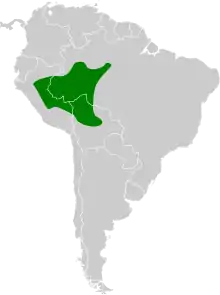| Inambari woodcreeper | |
|---|---|
 | |
| Scientific classification | |
| Domain: | Eukaryota |
| Kingdom: | Animalia |
| Phylum: | Chordata |
| Class: | Aves |
| Order: | Passeriformes |
| Family: | Furnariidae |
| Genus: | Lepidocolaptes |
| Species: | L. fatimalimae |
| Binomial name | |
| Lepidocolaptes fatimalimae Rodrigues et al., 2013 | |
 | |
The Inambari woodcreeper (Lepidocolaptes fatimalimae) is a species of bird in the subfamily Dendrocolaptinae of the ovenbird family Furnariidae.[2] It is found in Bolivia, Brazil, and Peru.[3]
Taxonomy and systematics
The Inambari woodcreeper was described in 2013 as part of the reevaluation of Lepidocolaptes albolineatus, which was then called the lineated woodcreeper. Starting in the early 2010s, all but the lineated's nominate subspecies were split from it, eventually resulting in recognition of the Inambari woodcreeper (which had not been known as a subspecies), the Duida woodcreeper (L. duidae), the dusky-capped woodcreeper (L. fuscicapillus), and a monotypic L. albolineatus which was renamed the Guianan woodcreeper.[4][5][6][2]
The Inambari woodcreeper's specific epithet honors Fátima Lima, manager of bird collections at the Museu Paraense Emílio Goeldi.[4]
The Inambari woodcreeper is monotypic.[2]
Description
The Inambari woodcreeper is 17 to 19 cm (6.7 to 7.5 in) long and weighs about 31 to 35 g (1.1 to 1.2 oz). It is a smallish, slim, woodcreeper with a slim decurved bill. The sexes have the same plumage. Adults' face, crown, and nape are dark russet-brown with few or no spots on the crown. Their back and wing coverts are dark russet-brown, and their rump, wings, and tail rufous-chestnut with dusky tips on the primaries. Their throat is plain buffy. Their breast and belly are grayish brown to olive-brown with bold, brownish-edged, buff to creamy white streaks. Juveniles have darker upperparts than adults, a grayer crown with some spots, and whiter, somewhat reduced, streaks on the underparts.[7]
Distribution and habitat
The Inambari woodcreeper is found in western Amazon Basin of eastern Peru, northern and central Bolivia, and western Brazil south of the Amazon River as far east as the Madeira River. It mostly inhabits terra firme and floodplain forest. It occurs less often in swamp forest and flooded várzea forest, and in shade coffee plantations in Peru. It favors the interior and edges of tall primary forest and mature secondary forest and is found only rarely in younger secondary forest. It elevation it seldom exceeds 1,000 m (3,300 ft) though it has reached 2,225 m (7,300 ft) in the Peruvian Andes.[7]
Behavior
Movement
The Inambari woodcreeper is believed to be a year-round resident throughout its range.[7]
Feeding
The Inambari woodcreeper's diet is primarily arthropods. It usually forages singly or in pairs, and often joins mixed-species feeding flocks. It hitches along branches, often on their underside, mostly in the forest's sub-canopy and canopy, occasionally in the middle levels, and rarely if ever in the understory. It takes most of its prey from bark, by picking, probing, and prying off flakes. It also sometimes probes vegetation like epiphytes but only infrequently sallies after airborne prey.[7]
Breeding
Little is known about the Inambari woodcreeper's breeding biology. Its breeding season seems to include late July to early August. It nests in cavities in trees. One nest contained two eggs.[7]
Vocalization
The Inambari woodcreeper's song differs from those of its former conspecifics; their songs were among the strongest evidence for their separation. Its song is "a soft trill comprising 16–37 notes (typically 26–33), like that of a becard (Pachyramphus) that trails off at end".[7]
Status
The IUCN has assessed the Inambari woodcreeper as being of Least Concern. It has a large range, and though its population size is not known it is believed to be stable. No immediate threats have been identified.[1] Because it is primarily a canopy specialist it is not well known; it is thought to be uncommon to fairly common throughout its range. It is "[b]elieved to be dependent on forest, thus likely to be highly sensitive to habitat modification".[7]
References
- 1 2 BirdLife International (2017). "Inambari Woodcreeper Lepidocolaptes fatimalimae". IUCN Red List of Threatened Species. 2017: e.T103670702A119210040. doi:10.2305/IUCN.UK.2017-3.RLTS.T103670702A119210040.en. Retrieved 12 July 2023.
- 1 2 3 Gill, Frank; Donsker, David; Rasmussen, Pamela, eds. (January 2023). "Ovenbirds, woodcreepers". IOC World Bird List. v 13.1. Retrieved 27 April 2023.
- ↑ Remsen, J. V., Jr., J. I. Areta, E. Bonaccorso, S. Claramunt, G. Del-Rio, A. Jaramillo, D. F. Lane, M. B. Robbins, F. G. Stiles, and K. J. Zimmer. Version 31 May 2023. Species Lists of Birds for South American Countries and Territories. https://www.museum.lsu.edu/~Remsen/SACCCountryLists.htm retrieved May 31, 2023
- 1 2 Rodrigues, E. B., A. Aleixo, A. Whittaker, and L. N. Naka. 2013. Molecular systematics and taxonomic revision of the Lineated Woodcreeper complex (Lepidocolaptes albolineatus): Dendrocolaptidae), with description of a new species from southwestern Amazonia. Pp. 248-257 in “Handbook of the Birds of the World. Special Volume: New Species and Global Index (J. del Hoyo, A. Elliot, J. Sargatal, and D. A. Christie eds.).” Lynx Edicions, Barcelona.
- ↑ Batista, Romina; Aleixo, Alexandre (December 2013). "Proposal (620) to South American Classification Committee: Recognize newly described Lepidocolaptes fatimalimae and split Lepidocolaptes albolineatus into four species". South American Classification Committee of the American Ornithological Society. Retrieved July 11, 2023.
- ↑ Remsen, J. V., Jr., J. I. Areta, E. Bonaccorso, S. Claramunt, G. Del-Rio, A. Jaramillo, D. F. Lane, M. B. Robbins, F. G. Stiles, and K. J. Zimmer. Version 31 May 2023. A classification of the bird species of South America. American Ornithological Society. https://www.museum.lsu.edu/~Remsen/SACCBaseline.htm retrieved May 31, 2023
- 1 2 3 4 5 6 7 del Hoyo, J., N. Collar, and G. M. Kirwan (2020). Inambari Woodcreeper (Lepidocolaptes fatimalimae), version 1.0. In Birds of the World (J. del Hoyo, A. Elliott, J. Sargatal, D. A. Christie, and E. de Juana, Editors). Cornell Lab of Ornithology, Ithaca, NY, USA. https://doi.org/10.2173/bow.inawoo1.01 retrieved July 12, 2023
